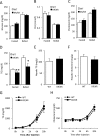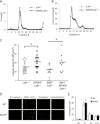Increased atherosclerosis and endothelial dysfunction in mice bearing constitutively deacetylated alleles of Foxo1 gene
- PMID: 22389493
- PMCID: PMC3340149
- DOI: 10.1074/jbc.M111.332767
Increased atherosclerosis and endothelial dysfunction in mice bearing constitutively deacetylated alleles of Foxo1 gene
Abstract
Complications of atherosclerosis are the leading cause of death of patients with type 2 (insulin-resistant) diabetes. Understanding the mechanisms by which insulin resistance and hyperglycemia contribute to atherogenesis in key target tissues (liver, vessel wall, hematopoietic cells) can assist in the design of therapeutic approaches. We have shown that hyperglycemia induces FoxO1 deacetylation and that targeted knock-in of alleles encoding constitutively deacetylated FoxO1 in mice (Foxo1(KR/KR)) improves hepatic lipid metabolism and decreases macrophage inflammation, setting the stage for a potential anti-atherogenic effect of this mutation. Surprisingly, we report here that when Foxo1(KR/KR) mice are intercrossed with low density lipoprotein receptor knock-out mice (Ldlr(-/-)), they develop larger aortic root atherosclerotic lesions than Ldlr(-/-) controls despite lower plasma cholesterol and triglyceride levels. The phenotype is unaffected by transplanting bone marrow from Ldlr(-/-) mice into Foxo1(KR/KR) mice, indicating that it is independent of hematopoietic cells and suggesting that the primary lesion in Foxo1(KR/KR) mice occurs in the vessel wall. Experiments in isolated endothelial cells from Foxo1(KR/KR) mice indicate that deacetylation favors FoxO1 nuclear accumulation and exerts target gene-specific effects, resulting in higher Icam1 and Tnfα expression and increased monocyte adhesion. The data indicate that FoxO1 deacetylation can promote vascular endothelial changes conducive to atherosclerotic plaque formation.
Figures




Similar articles
-
Dissociation of the glucose and lipid regulatory functions of FoxO1 by targeted knockin of acetylation-defective alleles in mice.Cell Metab. 2011 Nov 2;14(5):587-97. doi: 10.1016/j.cmet.2011.09.012. Cell Metab. 2011. PMID: 22055502 Free PMC article.
-
Homozygosity for an allele encoding deacetylated FoxO1 protects macrophages from cholesterol-induced inflammation without increasing apoptosis.Arterioscler Thromb Vasc Biol. 2011 Dec;31(12):2920-8. doi: 10.1161/ATVBAHA.110.219477. Epub 2011 Sep 22. Arterioscler Thromb Vasc Biol. 2011. PMID: 21940942 Free PMC article.
-
FOXO1 mediates the autocrine effect of endothelin-1 on endothelial cell survival.Mol Endocrinol. 2012 Jul;26(7):1213-24. doi: 10.1210/me.2011-1276. Epub 2012 May 8. Mol Endocrinol. 2012. PMID: 22570335 Free PMC article.
-
Forkhead box transcription factor 1: role in the pathogenesis of diabetic cardiomyopathy.Cardiovasc Diabetol. 2016 Mar 8;15:44. doi: 10.1186/s12933-016-0361-1. Cardiovasc Diabetol. 2016. PMID: 26956801 Free PMC article. Review.
-
Targeting FoxO1 for hypertriglyceridemia.Curr Drug Targets. 2011 Aug;12(9):1245-55. doi: 10.2174/138945011796150262. Curr Drug Targets. 2011. PMID: 21443465 Review.
Cited by
-
miR-183-96-182 clusters alleviated ox-LDL-induced vascular endothelial cell apoptosis in vitro by targeting FOXO1.RSC Adv. 2018 Oct 12;8(61):35031-35041. doi: 10.1039/c8ra06866f. eCollection 2018 Oct 10. RSC Adv. 2018. PMID: 35547044 Free PMC article.
-
Genetics of macrovascular complications in type 2 diabetes.World J Diabetes. 2021 Aug 15;12(8):1200-1219. doi: 10.4239/wjd.v12.i8.1200. World J Diabetes. 2021. PMID: 34512887 Free PMC article. Review.
-
When β-cells fail: lessons from dedifferentiation.Diabetes Obes Metab. 2016 Sep;18 Suppl 1(Suppl 1):117-22. doi: 10.1111/dom.12723. Diabetes Obes Metab. 2016. PMID: 27615140 Free PMC article. Review.
-
Impact of Abnormal Coronary Reactivity on Long-Term Clinical Outcomes in Women.J Am Coll Cardiol. 2019 Feb 19;73(6):684-693. doi: 10.1016/j.jacc.2018.11.040. J Am Coll Cardiol. 2019. PMID: 30765035 Free PMC article.
-
Identification of atherosclerosis-related prioritizing metabolites based on a multi-omics composite network.Exp Ther Med. 2019 May;17(5):3391-3398. doi: 10.3892/etm.2019.7351. Epub 2019 Mar 6. Exp Ther Med. 2019. PMID: 30988716 Free PMC article.
References
-
- Caro J. J., Ward A. J., O'Brien J. A. (2002) Lifetime costs of complications resulting from type 2 diabetes in the U.S. Diabetes Care 25, 476–481 - PubMed
-
- Holman R. R., Paul S. K., Bethel M. A., Matthews D. R., Neil H. A. (2008) 10-Year follow-up of intensive glucose control in type 2 diabetes. N. Engl. J. Med. 359, 1577–1589 - PubMed
-
- Duckworth W., Abraira C., Moritz T., Reda D., Emanuele N., Reaven P. D., Zieve F. J., Marks J., Davis S. N., Hayward R., Warren S. R., Goldman S., McCarren M., Vitek M. E., Henderson W. G., Huang G. D. (2009) Glucose control and vascular complications in veterans with type 2 diabetes. N. Engl. J. Med. 360, 129–139 - PubMed
-
- Rask-Madsen C., King G. L. (2007) Mechanisms of disease: endothelial dysfunction in insulin resistance and diabetes. Nat. Clin. Pract. Endocrinol. Metab. 3, 46–56 - PubMed
Publication types
MeSH terms
Substances
Grants and funding
LinkOut - more resources
Full Text Sources
Other Literature Sources
Medical
Molecular Biology Databases
Research Materials
Miscellaneous

